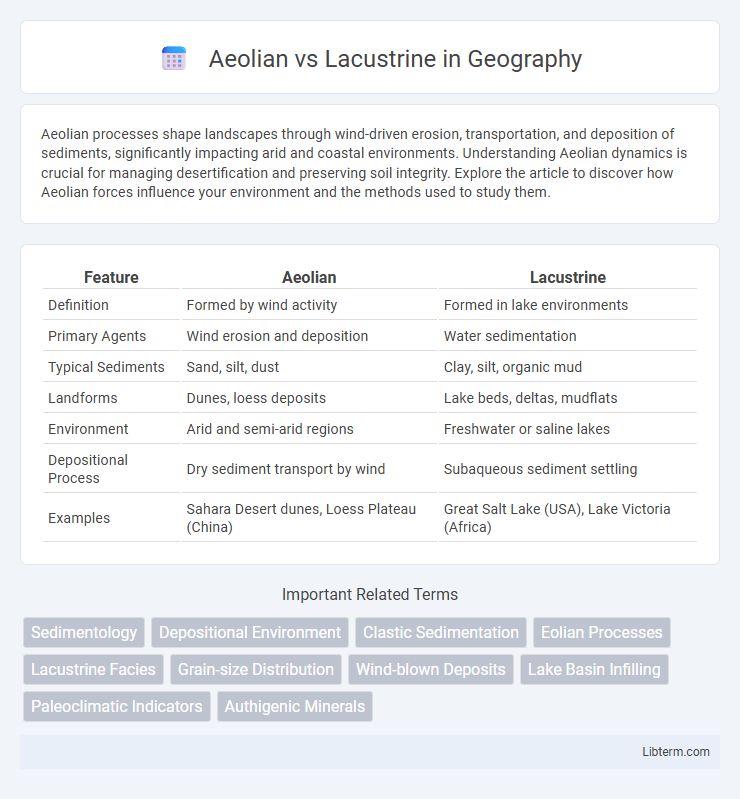Aeolian processes shape landscapes through wind-driven erosion, transportation, and deposition of sediments, significantly impacting arid and coastal environments. Understanding Aeolian dynamics is crucial for managing desertification and preserving soil integrity. Explore the article to discover how Aeolian forces influence your environment and the methods used to study them.
Table of Comparison
| Feature | Aeolian | Lacustrine |
|---|---|---|
| Definition | Formed by wind activity | Formed in lake environments |
| Primary Agents | Wind erosion and deposition | Water sedimentation |
| Typical Sediments | Sand, silt, dust | Clay, silt, organic mud |
| Landforms | Dunes, loess deposits | Lake beds, deltas, mudflats |
| Environment | Arid and semi-arid regions | Freshwater or saline lakes |
| Depositional Process | Dry sediment transport by wind | Subaqueous sediment settling |
| Examples | Sahara Desert dunes, Loess Plateau (China) | Great Salt Lake (USA), Lake Victoria (Africa) |
Understanding Aeolian and Lacustrine Environments
Aeolian environments are characterized by wind-driven processes that shape landscapes through the transport and deposition of sand and dust, commonly forming dunes and loess deposits. Lacustrine environments involve sedimentation in lake settings, where fine-grained sediments such as clays and silts accumulate under relatively calm water conditions, preserving organic matter and shallow water fossils. Understanding the distinct sedimentary features and processes of aeolian and lacustrine environments aids in reconstructing past climates and sedimentary basin evolution.
Formation Processes: Wind vs. Water
Aeolian formations develop through wind-driven processes, where sand and dust particles are transported and deposited by aerodynamic forces, creating features like dunes and loess deposits. Lacustrine formations form in lake environments through sedimentation, where water currents settle fine-grained sediments such as silts and clays on the lakebed, resulting in stratified sediment layers. The key distinction lies in aeolian processes relying on atmospheric dynamics for particle movement, while lacustrine processes depend on hydrodynamic sediment transport and deposition within standing water bodies.
Key Characteristics of Aeolian Systems
Aeolian systems are characterized by wind-driven sediment transport, resulting in well-sorted, fine to medium sand grains often forming dunes or ripple marks. These deposits typically exhibit cross-bedding and frosted grain textures due to abrasion during airborne transport. Aeolian environments are commonly found in deserts, coastal dunes, and some glacial outwash plains, contrasting with the water-deposited sediments of lacustrine systems.
Distinct Features of Lacustrine Systems
Lacustrine systems are characterized by their formation in lake environments, usually featuring fine-grained sediments such as clays and silts deposited in relatively calm water conditions. These systems often exhibit well-preserved organic materials and fossil records due to low-energy depositional settings. Lacustrine deposits contrast with aeolian systems by lacking the large-scale cross-bedding and well-sorted sands typical of wind-driven sedimentation.
Sediment Composition: Aeolian vs. Lacustrine
Aeolian sediments primarily consist of well-sorted, fine to medium sand-sized particles dominated by quartz and feldspar, often exhibiting frosted grain surfaces caused by wind abrasion. Lacustrine sediments contain a mixture of silt, clay, and fine sand, along with organic matter and carbonate minerals, reflecting quieter water deposition and chemical precipitation processes. The mineralogy in lacustrine environments frequently includes clay minerals like smectite and illite, contrasting with the more mechanically weathered, mineralogically stable grains typical of aeolian deposits.
Landforms Created by Aeolian Activity
Aeolian activity shapes distinctive landforms such as dunes, yardangs, and loess deposits through wind erosion and sediment transport. These features are typically found in arid and semi-arid environments where loose, dry sediments are abundant. In contrast, lacustrine landforms form from lake-related sedimentation processes, creating features like deltas, shorelines, and varves.
Notable Lacustrine Landforms and Deposits
Notable lacustrine landforms include deltas, terraces, and varved sediments formed by the settling of fine particles in lake environments. Lacustrine deposits are typically characterized by finely layered silts, clays, and organic materials that provide valuable records of past climatic and environmental conditions. These deposits often preserve fossils and chemical signatures, making them essential for paleoenvironmental reconstructions and sedimentological studies.
Environmental Significance and Ecological Impact
Aeolian deposits, formed by wind-driven processes, influence soil fertility and landscape shaping in arid and semi-arid environments, often supporting specialized desert ecosystems. Lacustrine sediments, deposited in lake environments, provide critical habitats for diverse aquatic and terrestrial species while acting as sinks for nutrients and contaminants, enhancing water quality and ecosystem resilience. The contrasting sedimentary dynamics impact carbon sequestration, biodiversity distribution, and long-term ecological stability in their respective environments.
Comparing Geological Records: Aeolian and Lacustrine
Aeolian deposits are characterized by well-sorted, fine to medium sand grains formed by wind action, often preserving cross-bedding and dune structures that indicate past arid environments. In contrast, lacustrine sediments typically consist of finer particles like silts and clays, with laminated layers reflecting fluctuating water levels and biological activity in lake settings. Comparing geological records of both reveals distinct sedimentary structures and mineral compositions that inform paleoenvironmental reconstructions and climate dynamics.
Applications in Earth Science and Environmental Studies
Aeolian deposits, formed by wind-driven processes, are critical for understanding desertification, paleoclimate reconstructions, and soil erosion patterns in arid environments. Lacustrine sediments, deposited in lake environments, provide valuable records for studying past hydrological changes, climate variability, and biogeochemical cycling in freshwater ecosystems. Comparing these deposits enhances interpretations of sediment transport, climate dynamics, and environmental change across different terrestrial landscapes.
Aeolian Infographic

 libterm.com
libterm.com